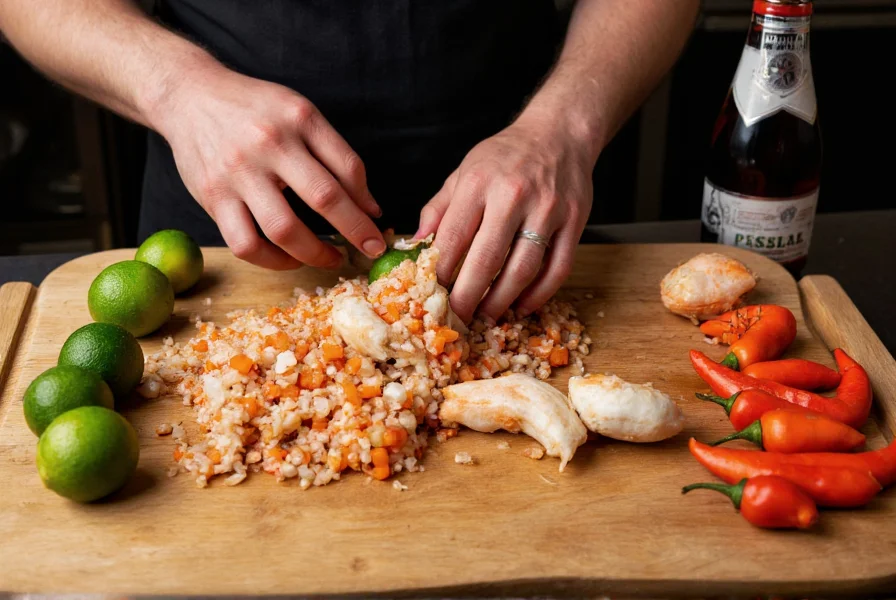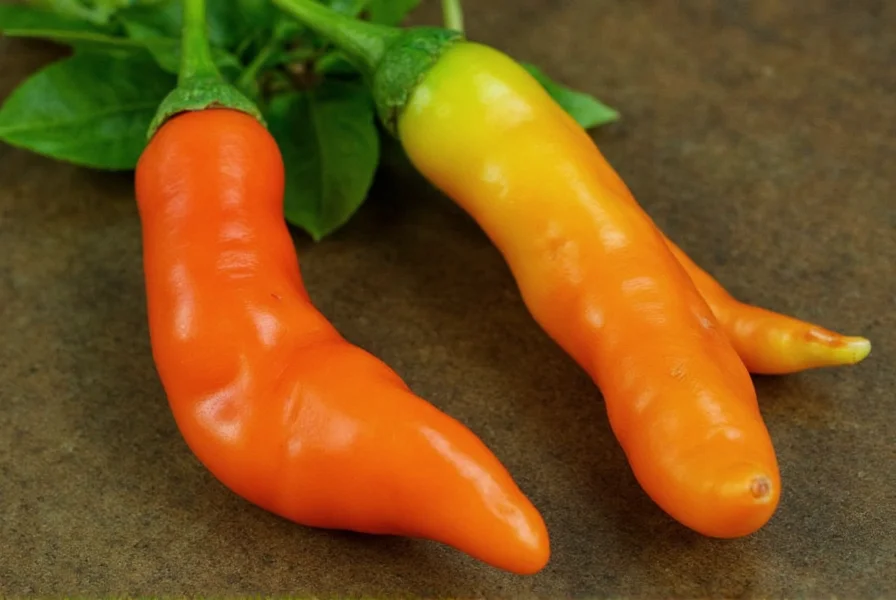Native to the Andean region of South America, the aji cachucha pepper (Capsicum chinense) has become increasingly popular among chili enthusiasts seeking authentic Latin American flavors without extreme heat. Unlike its fiery relatives, this unique pepper offers a balanced culinary experience that enhances dishes without overwhelming them.
Origin and Botanical Characteristics
The name "aji cachucha" translates to "pepper that fits in the palm of your hand" in Quechua, reflecting its small, lantern-shaped pods that typically measure 1.5-2 inches in length. These peppers grow downward on the plant rather than upright like many chili varieties, with thin walls that make them ideal for fresh applications rather than drying.
Botanically classified as Capsicum chinense (the same species as habaneros and Scotch bonnets), aji cachucha peppers demonstrate the remarkable diversity within this species. While most C. chinense varieties deliver intense heat, aji cachucha provides a more approachable experience while maintaining the characteristic fruity notes of its hotter cousins.
Flavor Profile and Heat Level
Understanding the precise heat level of aji cachucha peppers is essential for culinary applications. Unlike the common misconception that all Peruvian peppers are extremely hot, aji cachucha falls in the mild to medium range:
| Pepper Variety | Scoville Heat Units | Heat Comparison |
|---|---|---|
| Aji Cachucha | 30,000-50,000 SHU | 3-5 times hotter than jalapeño |
| Habanero | 100,000-350,000 SHU | 10-20 times hotter than jalapeño |
| Jalapeño | 2,500-8,000 SHU | Baseline for comparison |
The flavor profile of aji cachucha is where it truly shines. It offers a complex combination of:
- Citrus notes (particularly lemon and lime)
- Tropical fruit undertones
- Subtle earthiness
- Clean, bright finish
Unlike many hot peppers that deliver pure heat, aji cachucha provides distinct flavor that enhances rather than dominates dishes. The heat builds gradually, allowing the nuanced flavors to come through before the warmth becomes noticeable.
Culinary Applications of Aji Cachucha Pepper
In Peruvian cuisine, aji cachucha is indispensable for authentic preparations. Its versatility makes it suitable for both raw and cooked applications:
Traditional Peruvian Dishes
Chefs preparing authentic Peruvian ceviche often prefer aji cachucha over spicier alternatives because it complements rather than competes with the delicate seafood flavors. The citrus notes naturally enhance the lime-marinated fish while providing just enough warmth to stimulate the palate.
Peruvian hot sauces featuring aji cachucha typically include:
- Fresh aji cachucha peppers
- Lime juice
- Garlic
- Cilantro
- Minimal salt
This simple preparation preserves the pepper's bright flavor while creating a versatile condiment that elevates grilled meats, roasted vegetables, and traditional dishes like lomo saltado.
Modern Culinary Adaptations
Chefs outside Latin America have discovered creative ways to incorporate aji cachucha into diverse cuisines:
- Infused oils: Steeping fresh peppers in neutral oils creates a subtly spicy base for dressings
- Pickled preparations: Preserving in vinegar with garlic and spices extends shelf life while enhancing flavor
- Seafood enhancements: Adding to shrimp cocktails or fish tacos for authentic Latin flair
- Sauces and salsas: Blending with mango or pineapple for tropical heat

Growing Aji Cachucha Peppers
For gardeners interested in cultivating authentic aji cachucha peppers, understanding their specific needs is crucial. These tropical plants require:
- Warm temperatures (70-85°F ideal)
- Full sun exposure (6-8 hours daily)
- Well-draining soil with consistent moisture
- Approximately 75-90 days to maturity from transplant
Unlike some chili varieties that thrive in arid conditions, aji cachucha prefers moderate humidity levels similar to its native Andean environment. The plants typically reach 24-36 inches in height and produce abundant yields when properly cared for.
Substitutes for Aji Cachucha Pepper
When authentic aji cachucha peppers are unavailable, several alternatives can approximate their flavor profile while maintaining appropriate heat levels:
| Substitute Pepper | Similarity to Aji Cachucha | Adjustment Tips |
|---|---|---|
| Scotch Bonnet (yellow) | High flavor similarity, higher heat | Use 1/3 less quantity; remove seeds |
| Habanero (orange) | Moderate similarity, significantly hotter | Use 1/4 quantity; pair with citrus |
| Serrano | Lower flavor complexity, similar heat | Add citrus zest to enhance profile |
| Shishito (with citrus) | Much milder, different flavor | Use more quantity; add lemon zest |
The best substitution strategy involves not just matching heat but replicating the distinctive citrus notes. Adding a small amount of lemon or lime zest can help bridge the flavor gap when using alternative peppers.
Storage and Preservation Techniques
Proper storage extends the usability of fresh aji cachucha peppers:
- Refrigeration: Store unwashed peppers in a paper bag in the crisper drawer for 2-3 weeks
- Freezing: Flash freeze whole peppers on a tray before transferring to freezer bags (maintains texture better than pureeing)
- Pickling: Preserves both flavor and texture for 6+ months in the refrigerator
- Drying: Less effective than other methods due to thin walls, but possible for sauces
For maximum flavor retention, avoid washing peppers until ready to use, as excess moisture accelerates spoilage. The thin walls of aji cachucha make them particularly susceptible to mold if stored improperly.
Nutritional Benefits of Aji Cachucha
Beyond their culinary value, aji cachucha peppers offer notable nutritional benefits:
- Rich in vitamin C (one pepper provides approximately 130% of daily requirement)
- Contains capsaicin, which may support metabolism and pain relief
- Good source of vitamin A and antioxidants
- Negligible calories (about 4 calories per pepper)
- Contains compounds that may support cardiovascular health
The capsaicin content in aji cachucha, while lower than in hotter peppers, still provides potential health benefits without the gastrointestinal discomfort that extremely spicy peppers can cause for sensitive individuals.
Common Misconceptions About Aji Cachucha Peppers
Several myths persist about this versatile pepper:
- Misconception: All Peruvian peppers are extremely hot
Reality: Peru has incredible pepper diversity, with many mild varieties like aji dulce - Misconception: Aji cachucha is the same as aji amarillo
Reality: They're distinct varieties with different heat levels and flavor profiles - Misconception: The seeds contain all the heat
Reality: Capsaicin is concentrated in the placenta (white ribs), not primarily in seeds - Misconception: Color indicates heat level
Reality: Heat is consistent across color stages; color indicates ripeness

Conclusion
The aji cachucha pepper represents the perfect balance for those seeking authentic Latin American flavors without overwhelming heat. Its distinctive lantern shape, citrusy flavor profile, and moderate heat level (30,000-50,000 SHU) make it an invaluable ingredient for both traditional Peruvian cuisine and modern culinary innovations. Whether you're preparing authentic ceviche, creating innovative sauces, or simply looking to expand your pepper repertoire, aji cachucha offers a versatile flavor experience that enhances rather than dominates dishes. As availability increases in specialty markets and through online seed suppliers, this once-regional specialty is becoming accessible to home cooks and professional chefs alike, bringing authentic Andean flavors to kitchens worldwide.
Frequently Asked Questions
How hot is an aji cachucha pepper compared to common varieties?
Aji cachucha peppers measure between 30,000-50,000 Scoville Heat Units (SHU), making them approximately 3-5 times hotter than jalapeños but significantly milder than habaneros (100,000-350,000 SHU). Their heat builds gradually, allowing their distinctive citrus flavor to shine through before the warmth becomes noticeable.
What's the best substitute for aji cachucha when unavailable?
The closest substitute is yellow Scotch bonnet pepper used at 1/3 the quantity (due to higher heat), with added citrus zest to replicate the distinctive lemon-lime notes. For milder alternatives, serranos with lemon zest or shishito peppers with additional citrus can work in a pinch, though they lack the authentic flavor profile.
Can aji cachucha peppers be eaten raw?
Yes, aji cachucha peppers are commonly eaten raw in Peruvian cuisine, particularly in ceviche and fresh salsas. Their moderate heat level and bright citrus flavor make them ideal for raw applications where hotter peppers would overwhelm delicate ingredients like seafood.
How do I grow aji cachucha peppers successfully?
Aji cachucha requires warm temperatures (70-85°F), full sun (6-8 hours daily), and well-draining soil with consistent moisture. Start seeds indoors 8-10 weeks before last frost, transplant after danger of frost has passed, and provide support as plants mature. They typically produce harvestable peppers in 75-90 days and thrive in moderate humidity similar to their native Andean environment.
What makes aji cachucha different from aji amarillo peppers?
While both are Peruvian peppers, aji cachucha is milder (30,000-50,000 SHU) with distinct citrus notes and a lantern shape, whereas aji amarillo is significantly hotter (30,000-50,000 SHU) with a more floral, fruity profile and elongated shape. Aji amarillo is typically used dried and ground, while aji cachucha shines in fresh applications due to its thin walls.











 浙公网安备
33010002000092号
浙公网安备
33010002000092号 浙B2-20120091-4
浙B2-20120091-4